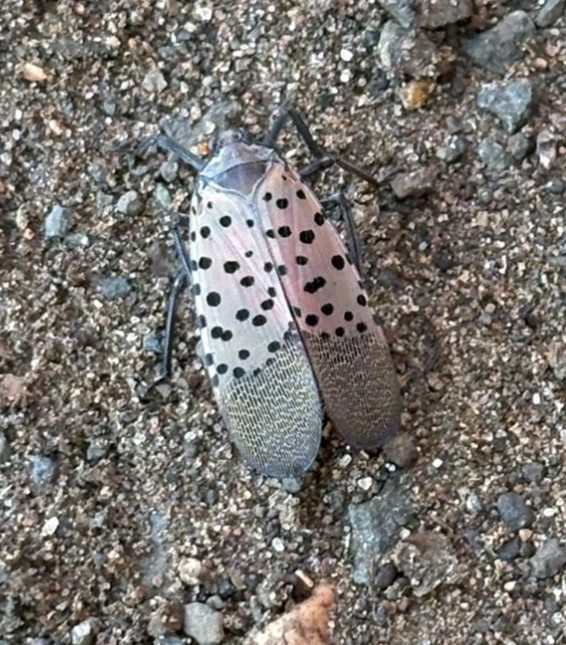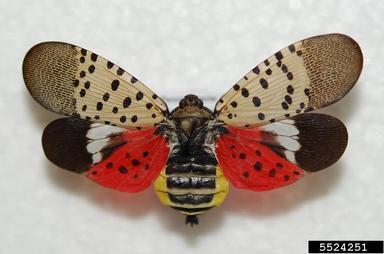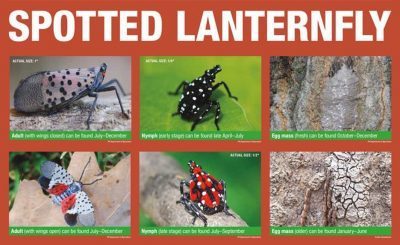The spotted lanternfly, an invasive insect that is a threat to agriculture and a variety of trees and vines, has been spotted in Vernon. Two were recently found in Vernon. There are infestations of the pest elsewhere in Connecticut.
The Garden Barn Nursery on West Road reported finding one last month. Jeff Schambach, lead foreman with Vernon Public Works and the town’s tree warden, found one recently at the public works garage on Hartford Turnpike.
“These insects are in Vernon and it’s important that if people see them, they kill them,” Schambach said. “Spotted lanternfly is a real threat to our state’s agricultural industry and we all can help limit the population.”
Spotted Lanternflies are not a threat to people or pets, as they do not sting or bite. They primarily feed on the sap of 70 - 100 different types of plants. This time of year, spotted lanternflies are entering their adult stage, characterized by their gray wings with black spots and a set of red hindwings underneath. Residents are encouraged to watch for these insects, especially in areas with grapevines, tree-of-heaven, bittersweet, maple, or black walnut.
The insect is an invasive planthopper, native to Asia, that was first detected in southeastern Pennsylvania in 2014. It has since spread to multiple states, and in 2020, two small established populations were found in Fairfield County. As of July 2025, spotted lanternfly has been spotted in all Connecticut counties, but sustaining populations have not been confirmed in every county.
 An adult spotted lanternfly found by Vernon Public Works Lead Foreman Jeff Schambach.
An adult spotted lanternfly found by Vernon Public Works Lead Foreman Jeff Schambach.
Why the spotted lanternfly of such concern to Connecticut?
The spotted lanternfly feeds on about 60 genera of the trees and plants found in North America. In Connecticut, about 47 percent of forest trees are considered as potentially susceptible to the insect. Many of the fruit trees grown in Connecticut, such as apple, cherry, and peach, are also considered to be vulnerable. Even if the insect does not kill the trees, it could destroy the value of the fruit. Grapes are likewise vulnerable. The impact on the agricultural industry of Connecticut could be devastating, according to the Connecticut Department of Environmental Protection.
The degree of impact of the spotted lanternfly on Connecticut's urban and rural forest trees is uncertain. It may turn out to be more of an annoyance with minor impact on forest health. However, there is the potential that it could cause much more significant damage.
 An adult spotted lanternfly.
An adult spotted lanternfly.
Their feeding also creates a sticky, sugary residue called “honeydew.” This honeydew attracts other insects and promotes the growth of a black mold called “sooty mold,” which can further damage the plant by blocking photosynthesis in the leaves of plants coated with the excrement.
The honeydew itself is sticky, unsightly and hard to get rid of, which is why the spotted lanternfly poses such a problem to fruit farmers. The presence of the honeydew can destroy the value of the crop.
The following are at risk from the spotted lanternfly: apple, beech, black and paper birch, black gum, cherry trees and cherries, dogwood, elm, grapes, hops, linden, maple, nectarines, oak, peaches, pignut and shagbark hickory, pine, plums, poplar, sycamore, tulip poplar, walnut, white ash and willow.
What should you do if you see a spotted lanternfly? Take a photo then KILL IT. Seriously. Kill it. They are really bad.
See the Connecticut Agricultural Experiment Station website for guidance on the management of spotted lanternfly and more information. https://portal.ct.gov/caes/caps/caps/spotted-lanternfly---slf
Using the reporting tool, people can submit a report if they suspect they have found spotted lanternfly. Take a picture of the insect and make note of your address. Reports without photos cannot be processed. Responses are not guaranteed, as CAES is receiving a significant number of inquiries and will follow up if necessary. All reports are confidential.
The State of Connecticut does not currently have a public program for the control of spotted lanternfly or removal of tree-of-heaven.

